SPECworkstation 3.0.2 Storage Benchmark
SPECworkstation benchmark is an excellent benchmark to test systems using workstation-type workloads. In this test, we only ran the Storage component, which is fifteen separate tests.
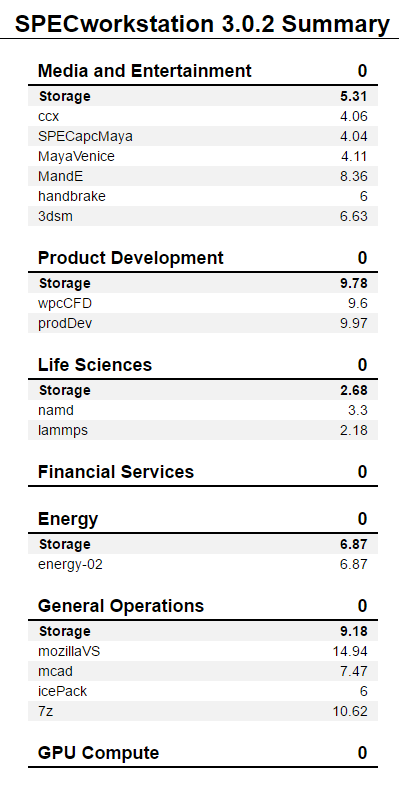
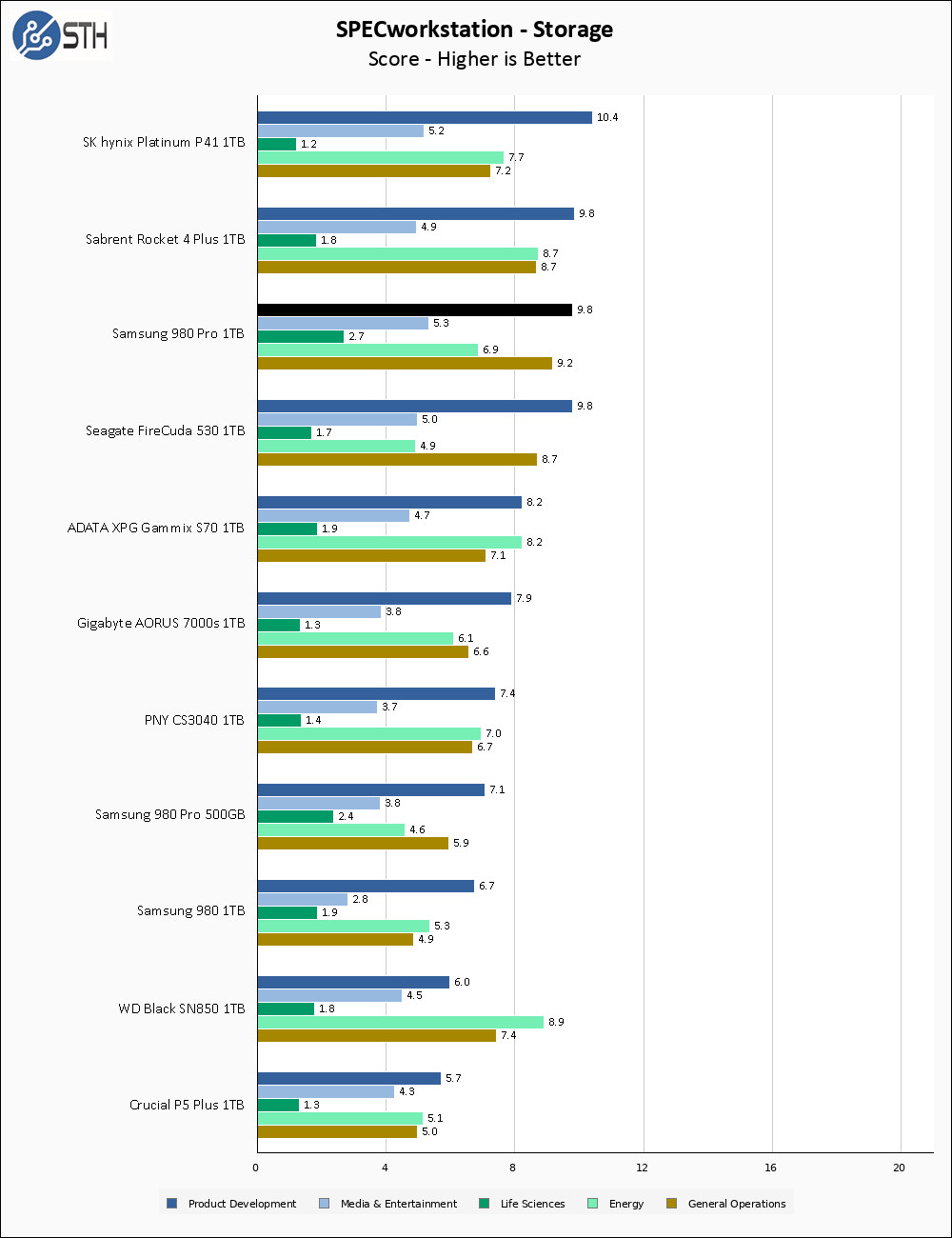
SPECworkstation performance on the Samsung 980 Pro is outstanding. Performance in this test most closely mirrors the Seagate FireCuda 530, except better in almost every test. Trading blows with the P41 and Rocket 4 Plus is a good position to be in as far as SPECworkstation results are concerned.
Sustained Write Performance
This is not necessarily a benchmark, so much as trying to catch the post-cache write speed of the drive. While I am filling the drive with data to the 85% mark with 10 simultaneous write threads, I monitor the drive for the write performance to dip to the lowest steady point and grab a screenshot.
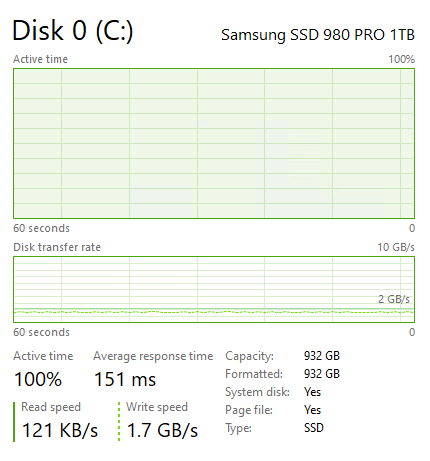
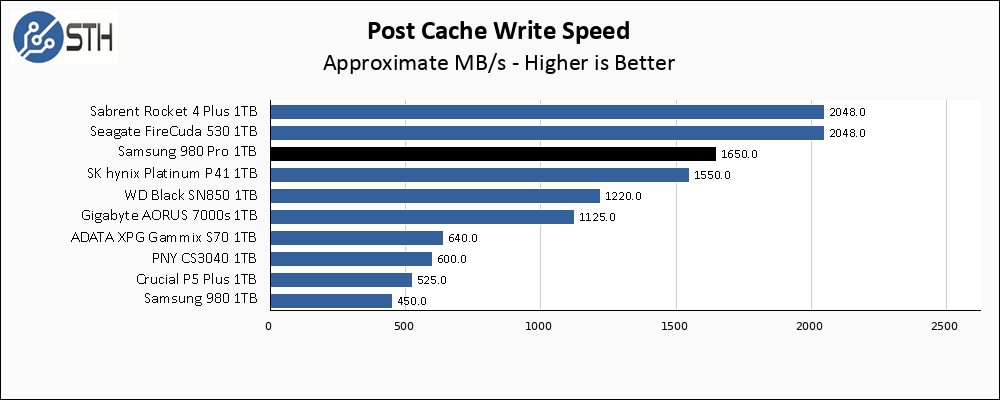
The Post-cache write speed on the Samsung 980 Pro is excellent, coming in just between the P41 and the Rocket 4 Plus / FireCuda 530.
Direct Comparisons – Size Matters
As mentioned earlier, we previously tested the 500GB version of this drive, so I wanted to illustrate how much of a difference the capacity can make in performance results.
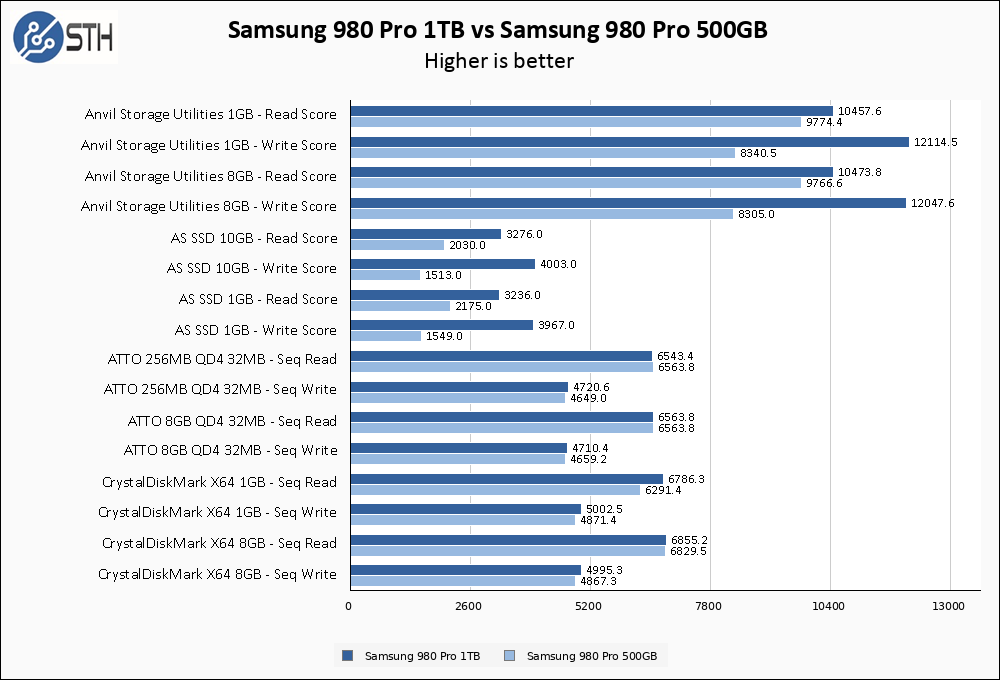
Almost across the board, the 1TB version of the 980 Pro manages a moderate to a significant advantage over the 500GB version. This is why the 500GB drive is not included in performance graphs when testing new drives. In earlier PCIe 4.0 drive reviews my sample set of drives was too small and so I included every drive I had just to fill up the graph, but now that I have tested a large variety of drives I strive to ensure that comparisons are as fair as possible.
Temperatures
We monitored the idle and maximum temperature during testing with HWMonitor to get some idea of the thermal performance and requirements of the drive. Please keep in mind that our test bench is an open frame chassis in a 22C room, but with no direct airflow. As a result, this is not representative of a cramped low airflow case and is instead intended to model temperatures of a drive ‘on its own’.

Under intense testing, the 980 Pro just touches 80C. This is significantly warmer than the 500GB drive gets and is definitely hot enough to justify a heatsink. I did not notice any throttling behavior, but I performed testing with a heatsink just to be safe.
Final Words
Today the Samsung 980 Pro 1TB is $155 online. That price point is very close to other top-end drives like the WD Black SN850, Sabrent Rocket 4 Plus, and Seagate FireCuda 530. While the performance of the 980 Pro is a minor step behind some of the other offerings, it is not so far behind that most users will notice the difference so I think this price is mostly justified.
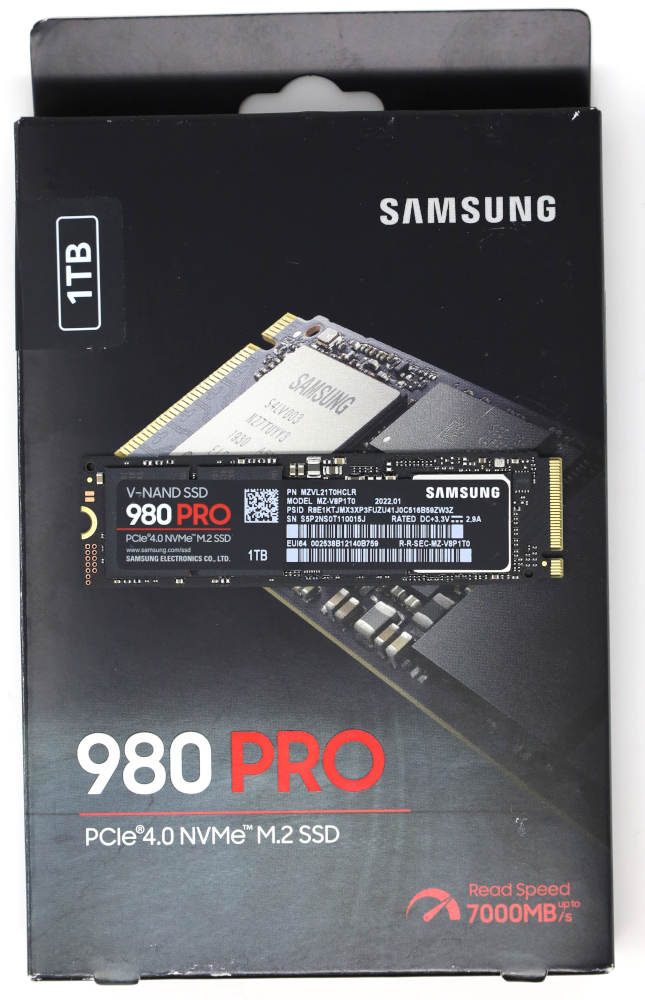
With the 980 Pro Samsung has continued its tradition of high-quality SSDs they started with SATA drives. While Samsung’s offering no longer stands head-and-shoulders above the pack like it did during the SATA SSD era, overall drive quality remains high and performance is competitive in almost every benchmark. Given equal pricing, I would personally probably choose either the FireCuda 530 or the Sabrent Rocket 4 Plus just for the write endurance and slightly higher performance, but for almost everyone the Samsung 980 Pro represents a completely viable option for high-end SSD performance.




3bit MLC is TLC. samsung is trying to mask that they greatly reduced the endurance compared to 970 pro.
with that change there’s less reason to buy 980 pro compared to 980 evo plus
altmind: there is nothing like “980 evo plus”. Only “980pro”, or “980”. They might have the same cells (TBW is the same), but I guess there must be different controller (maybe more channels?), as 980pro has about twice higher iops and r/w…
I’ve noticed the white gloves in many of these SSD reviews.
Are the gloves to prevent scraping biometric fingerprint data from a close-up photo?
Do the gloves have antistatic properties?
Are the gloves intended to prevent the electrical contacts on the SSD from getting dirty?
Thanks for all the work. I’ve found these reviewers useful when making purchasing decisions.
Thanks for an interesting review. I was long wondering why samsung drives are missing on the graphs.
Eric,
The white gloves have a much more mundane explanation: my fingers always seem to be cut up or injured from one thing or another, so gloved white fingers look better than a bloody mess. When I bought my open-frame test bench it came with some white gloves, presumably because part of it is lexan and to prevent fingerprints, and at some point I was racking my brain on something different to use for a drive picture and decided just put on the gloves and hold the dang thing. That’s all 🙂
As a relatively new reader I am wondering why all the focus in these SSD reviews is on sequential read and write results? My understanding is that random read and access time is crucial to how fast a drive will perform and feel in daily use, so it would be nice to see those numbers compared in a graph. The instances where you’d be writing to the drive at 7+GBps in every day use would be small, while you will always be doing random reads and writes for booting, opening apps, saving documents, etc.
Great reviews, Will, thank you!
Interesting are the “post cache” writes, maybe you are able to plot those from the beginning of a test upto the point where the cache is full and the speeds do not change anymore, to determine cache size?
Also – how fast would the cache empty, e.g. you write 10 GB and wait 5 sec, then dump another few GB into the SSD.
JJ,
The ‘focus’ as you put it is on sequential numbers because they are the statistic most commonly cited by manufacturers as a performance metric; the front of the box on the SSD will say “7000 MB/s” on it, not quote a 4K random read number. I provide some focus here because I like to ensure manufacturers ‘do what they say’ and actually hold up their end of the bargain. In addition, random performance is harder to directly quantify because there are a bunch more factors that play in that are workload specific. With that said, 3 of my tests (Anvil, ASSSD, and SPEC) are all heavily influenced by non-sequential performance, so I don’t feel like I ignore that aspect of the performance.
Jay,
There are benchmark utilities that can track write speed across an entire disk like that, but the method I use to perform this test does not have that capability. I use multiple instances of a utility for creating randomized data – not a benchmark utility – and then just measure disk performance ‘from the side’ by looking at task manager. I will eventually run into performance problems with this method; my ability to generate random data is CPU limited and tops out at around 5 GB/s, so when SSDs can sustain write speeds at 5 GB/s or greater I’ll have to change methodologies or get a faster CPU.
As for how fast the cache will empty, that depends on a bunch of factors. If the drive is at a reasonable percentage of use – like 60-80% full – and TRIM has been run somewhat recently (Windows runs it weekly by default) then if you write out 10 GB of data it should get ‘unspooled’ from the cache relatively quickly. This behavior is somewhat unofficially tested as part of my benchmarks – after filling the drive and then reducing to the testing capacity (between 60% and 70% full) I very rapidly run all the benchmarks back-to-back, not allowing the drive time to idle. Some drives with poor cache handling do not respond well to this and it shows up in their results.
Will, Appreciate your thoughtful testing procedures. As I deal with upgrades frequently for older systems I run into RAM maxed out and SSDs needed for swapping/paging, where any Cache helps.
I would certainly go for the SK Hynix P41 over this Samsung 980 Pro, as of which you can’t call the endurance pro. Samsung is preferring price/volume over quality/endurance.
Works great on Windows 7 with a Microsoft hot fix then the nvme driver installed I get over 6, 000 mb read and writes Dell 5570 i7
Users should update firmware
Samsung recommends users to upgrade to the current version 5B2QGXA7. The firmware update is possible via Samsung’s Magician SSD tool (download at the end of the message). The user data is actually retained, but a backup is always recommended before a firmware update, just in case.
According to the investigations by Puget Systems, 980 Pro with the firmware versions 4B2QGXA7 and the said 5B2QGXA7 should not be affected.
It’s too late for those affected
However, if the SSD has already failed, which is usually reflected in the fact that the 980 Pro (test) is suddenly in read-only mode, this solution comes too late. The firmware update can prevent the problem from occurring, but cannot reverse it if a drive has already failed.
I had one of these. It was great at first but then it wouldn’t boot correctly. Read another article about issues with dependability